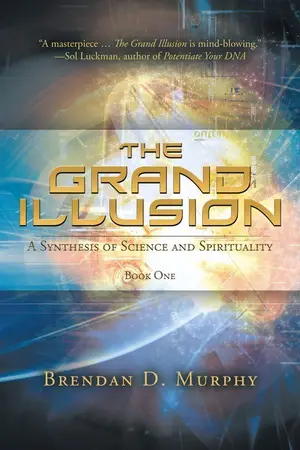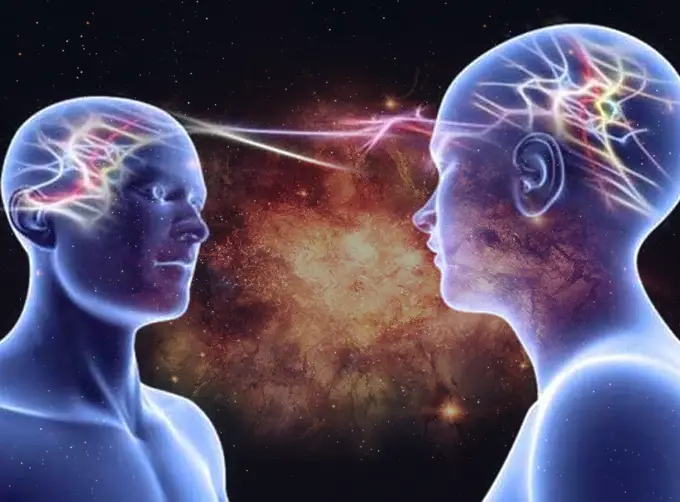Guest Writer for Wake Up World
“Those who reject even telepathy have reached the point where they are impugning either the honesty or the sanity of several thousand scientific researchers on all major continents over a period of decades. Such expedient ways of disposing of data are shared only by the most ardent anti-Evolutionists among the Fundamentalist sects.” ~ R.A. Wilson, from the book Cosmic Trigger.
Thoughts Through Space
The term “telepathy” was coined in 1882 by Frederick W.H. Myers, a founding member of the London Society for Psychical Research (SPR). The word means “feeling at a distance”, though this may be slightly misleading in that this is not usually how the term is deployed. Telepathy is essentially mind-to-mind contact, or the exchange of information between two different consciousnesses separated by an arbitrarily large distance (it doesn’t matter how large). Though many of the more narrow-visioned would claim any discussion involving telepathy is “unscientific” by default, we can see that many years ago there were eminent scientists who not only recognized its existence but sought to understand the phenomenon.
[pro_ad_display_adzone id=”110028″]
The first studies of telepathy were based on collections of spontaneous experiences, with 1886 seeing the publication of the seminal classic Phantasms of the Living, by the British scholars Edmund Gurney, Frederick Myers, and Frank Podmore — who actually took the time and effort to analyse all reports to identify the best and most reliable cases for publication and eliminate the fraudulent.[1]
Over a decade later, the eminent chemist and physicist Sir William Crookes — also an avid and meticulous researcher into “paranormal” phenomena — spoke on telepathy before the Royal Society at Bristol, England, in 1898. This address was, in the words of occultist Swami Panchadasi (a.k.a. William Walker Atkinson), “made before an assemblage of distinguished scientists, many of them rank materialists and quite skeptical of all occult phenomena.” Crookes, facing this gathering as its president, expressed the view that it is a “fundamental law… that thoughts and images may be transferred from one mind to another without the agency of the recognized organs of sense — that knowledge may enter the human mind without being communicated in any hitherto known or recognized ways.”[2]
If telepathy occurs, he continued, “we have two physical facts — the physical change in the brain of A, the suggestor, and the analogous physical change in the brain of B, the recipient of the suggestion.” While Crookes would eventually be vindicated in these comments by the development of the EEG and other modern technology and experimental designs, he assumed that “between these two physical events there must exist a train of physical causes”,[3] which we can accept if we modify our definition of “physical” to include subtle energies (such as torsion/scalar fields), as well as the plasma-like particulate matter of the various aetheric densities (etheric, astral, mental, etc.).
In the modern world, the commonest kind of human telepathy occurs in connection with telephone calls, according to biologist and paranormal researcher Rupert Sheldrake. Over 80% of people claim to have thought of someone for no apparent reason, who then phoned them; or that they have known, in a telepathic sort of way, who was on the phone before answering it. Sheldrake reports that controlled experiments have provided highly statistically significant repeatable positive results.[4] Many people (probably about 80%!) however, will need no convincing of the fact, as repeated personal experience has a way of making experimental proofs a little bit redundant sometimes.
A World-First Experiment in Telepathy
In 1942 the remarkable though little-known book Thoughts Through Space, by Australian-born aviator-explorer Sir Hubert Wilkins (1888–1958) and American author, playwright, and “sensitive” Harold Sherman (1898–1987), was published. It detailed the first experiment (conducted from late 1937 through to early 1938) of its kind: a long-distance and long-term telepathy experiment where Wilkins, who was aiding in the aerial search for a missing Russian craft and its crew in the Arctic, would attempt to telepathically send information regarding his activities to Sherman, who would attempt to receive the messages and record them. This would take place over a period of some five months.
However, as it turned out, Wilkins never got the opportunity to take time to deliberately send any impressions to Sherman, who faithfully conducted his “psychic vigil” each night at the same time, ever unaware of Wilkins’ situation or activities. What Wilkins did instead was to record events and details in his log, this being the usual habit with an explorer. When Wilkins returned from the Arctic, his dated log was compared with the dated impressions of Sherman so the latter’s psychic accuracy and reliability could be assessed.[5]
Early in the book, Wilkins made a point of noting that, a) Sherman had already demonstrated his ability to receive impressions without the necessity of Wilkins’ consciously willing thoughts to him at the time of their scheduled “sittings,” and, b) Sherman could respond directly to Wilkins’ thoughts on the occasions he was able to keep their “psi appointments.”[6]
The role of emotion was significant in these experiments (as it is in many psi experiments), as the two participants ultimately acknowledged. Wilkins noted that despite his inability to regularly keep to the appointed “sending” time for the experiments, he did continue his habit of thinking the unusual incidents strongly to Sherman. When Wilkins was anxious, Sherman seemed to be particularly effective at detecting his thoughts.[7]
Wilkins also agreed with the occultist’s axiom that the intensity of a sender’s emotional reaction to what is happening to him, or has happened, determines the degree of intensity of the “thought-waves” discharged.[8] (In my book The Grand Illusion: A Synthesis of Science and Spirituality (Vol.1), I have portrayed these thought waves as torsion/scalar waves in the vacuum/aether/zero point field/time-space/implicate order.)
Also worth noting is that in some ways, this epic experiment — lasting as it did over five months — was something of a precursor to what would later become known as remote viewing. It also featured elements of prevision, evincing a predictable unpredictability so common to psi functioning, thus blurring the lines[*] between telepathy in real time and other forms of clairvoyance — much as this tended to occasion Sherman’s uncertainty as to precisely what he was seeing at the precise moment of seeing. Sometimes visions would turn into previsions, precipitating out of the aether days later without apparent warning. This was a complicating factor at times, as was the initial lack of feedback for Sherman, which caused him a degree of anxiety (was he “hitting” more than missing?). Nevertheless, the experiment overall can only be described as a stunning success, with some indisputably spectacular hits by Sherman to be found scattered throughout.
Official Results
Sherman sat three times a week to act as receiver, depositing copies of his nightly impressions to third party witnesses to ensure there could be no question of his having failed to record his impressions before receiving Wilkins’ log. Let’s look at some of the data. Sherman’s report of Wilkins’ activities for February 14 reads:
“Impression you talked three times before different interested groups since arrival at Edmonton — first time before some luncheon club — like Rotary Club — you have found a motor — you plan to take off with it tomorrow or Wednesday, if weather permits. You have dinner with three men and their wives…One of Edmonton’s wealthiest and most prominent men has entertained you and given you some assistance relative to the expedition — word McKenzie flashes to my mind — is there a company of that name supplying you with plane? Seem to see you as guest of Church Brotherhood… Sunday occasion — you called on to speak—you have appointment with two men who will take you to some plant or place where you will see the packing of the equipment.”[9]
Keep in mind that Sherman had been receiving little feedback on previous recordings prior to this session, and had not been forewarned of any of these activities, making it all the more remarkable that Wilkins was able to subsequently confirm every detail, including the fact that McKenzie Airways were furnishing the plane that would fly the new engine back to Aklavik. All of these things took place between February 10 and 14.[10]
As noted, sometimes the information being received by Sherman was a blur of present (or recent past) information and information pertaining to some point in the future. Wilkins stated that in his March 1 record Sherman had recorded almost all of his most prominent thoughts as well as describing the conditions Wilkins experienced.[11] The latter part of the entry from Sherman mentions liquor in connection with a commercial interest (possibly a company seeking his endorsement). Sherman states that Wilkins is wondering whether they will offer him enough money for it, and then moves on to things flight-related. He suggests checking the oil and gas lines leading to the engine as a possible source of trouble—“something appears to get clogged or choked” as a result of the low ambient temperature.
Wilkins’ analysis of Sherman’s psi report confirms that Hiram Walker had indeed sought Wilkins’ endorsement for a certain whiskey, but did not offer sufficient remuneration to garner Wilkins’ advocacy. It was the one time that year that Wilkins had received such an offer. As for Sherman’s concern over gas and oil lines, sure enough, the next day during flight, the feed on the automatic control did clog. Towards evening, the oil temperature indicated some clogging of the line, according to one of Wilkins’ collaborators (Cheeseman) on the plane with him.[12]
Evidently, darkness proved to be an aid in Sherman’s sittings, eliminating visual stimuli so he could become more receptive to the nonlocal stimuli filtering through from his subconscious mind.[13] Sitting in darkness to receive psi information is a good and standard way to increase the psi signal to noise ratio (not dissimilarly to Ganzfeld tests).
An interesting fact to note is that after some time of sitting three times a week for his sessions, Sherman had trained his subconscious to feed him psi information more consistently. He commented that his mind had become so highly sensitized and habituated to the psi task that it continually brought him un-asked-for impressions and “unusual mental flashes.” These flashes appeared sometimes to come from the mind of anyone he focused his attention on, regardless of the fact that there were unbidden insights he did not seek. There are many pieces of evidence that demonstrate that the psi faculty, like our muscular system, is responsive to training. This has been known to mystics and occultists for many centuries.
As well as this, Sherman suffered serious ill health effects because of his other commitments, which left him virtually no rest and recovery time. We need not go into Sherman’s exact method in eliciting his results, but it is worth noting that during the sessions he could feel his mind “contact” Wilkins’ mind, he sensed a force, line, or stream of energy which seemed to connect the two subconscious minds of the men. During the sittings when he felt this sensation the strongest, he got his best results.[14]
A conclusion reached by both men (and one in full accordance with occult thought) was that the degree of intensity of emotional reaction to external experience determines the intensity of the thought force projected. In their view, human emotions were the power source behind the electrical currents of the brain.[15] A recurring motif in “paranormal” and parapsychological research is the important role of emotion, creative force that it is.[16]
Sherman also noted that he sensed thought impressions at two places in his body: the brain (center of crown and third eye chakras) and solar plexus (where the manipura chakra is).[17] He would get a nerve reaction in the pit of his stomach (not unlike that felt when one receives a sudden shock or becomes anxious), which he came to realize always accompanied a genuine telepathic communication.[18] Elsewhere, in his psi research, Dr. Hiroshi Motoyama has connected the lower three chakras (one of which is the solar plexus chakra/manipura) with passive or receptive psi abilities, such as Sherman employed in this telepathy experiment.[19]
On top of Sherman’s amazingly accurate reports of Wilkins’ far removed activities either as they happened or soon after, he also sensed events yet to happen to Wilkins, as previously noted. Wilkins only had two accidents occur involving his plane during his five months away, and Sherman sensed both ahead of time, witnessing previsions of these events days before they happened.
To give further insight into the remarkably successful nature of this experiment, several friends and/or collaborators of Sherman and Wilkins signed affidavits testifying to the validity of the experimental procedure as well as Sherman’s undeniable accuracy. Dr. Henry S.W. Hardwicke, a research officer for the Psychic Research Society of New York, stated in his affidavit that the authenticity of the telepathic phenomena was unquestionable.[20] Dr. A.E. Strath-Gordon was effusive in his own affidavit, stating that Sherman’s amazing telepathic consistency, clarity, and accuracy was something he had not seen in all his years of research around the world. Such was Sherman’s telepathic acuity that, to Strath-Gordon, it seemed almost as if he was taking dictation from some unseen intelligence.[21]
This is not to construe that Sherman only ever “hit” and never “missed.” He did, as any intuitive will, miss occasionally, but more often than not he was accurate, far too often and with such exquisite detail that it cannot logically be asserted that he obtained his results by lucky guesses over this extended period, and no evidence at all exists to implicate anyone in any fraudulent activities. But for the most part, even Sherman’s misses were intriguingly close to the mark, seemingly mixing fact with fiction.[22]
Little more need be said to convince the sane of the success of this epic psi experiment. However, Sherman’s talents provide much food for thought. For instance, it is notorious among psychics that sensing specific numbers, dates, names, and such particulars represents one of the most difficult tasks. Sherman was exceptional at sensing names of people, companies, and more, as well as having some spectacular hits with numerical data (remembering that he was operating totally “blind” to Wilkins’ Arctic activities).
On November 30, one of his data points was simply this: Latitude 68, Longitude 133. Wilkins recorded: Latitude 68, Longitude 135. These numbers bear no further comment. In his next sitting (December 2), Sherman recorded several spectacular hits, including a note of the intended first flight of Wilkins which was to be a distance of 600 miles. In his own notes, Wilkins had recorded that this flight was indeed slated to be 600 miles.[23] Note again that Wilkins did not offer foreknowledge of his intended plans or movements in these letters.
To add yet another complicating factor to all of this, Sherman found that it was difficult to distinguish between a thought in the mind of an individual and the actual materialization of that thought in action. He said he was certain that there had been occasions where he had unwittingly confused these two thought-forms.[24]
In his many experiments several decades later, former CIA polygraph expert Cleve Backster found, interestingly, that his plants — leaves wired to a polygraph machine — initially encountered something of a similar situation when it came to detecting silent human intent to harm them, though they rapidly learned to distinguish between real and imagined threats.[25]
The process for a human attempting telepathy seems to present more challenges — perhaps because plants do not have much in the way of an individuated conscious mind to block subconscious perceptions: they belong to a group consciousness or “morphic field,” and lack a personal subconscious. The human, whether particularly intelligent or not, has this discriminatory disadvantage built in. So, while it may not be much of a compliment to be told you have the intelligence of a house plant, it could, in a sense, be something of an accolade to be told you have the intuition of one!
In January 1938, Sherman made some interesting notes regarding some technicalities of the telepathic downloading process. At 11.30 on the designated nights of the appointments, wherever he was he would begin to receive strong feelings from Wilkins. He stated that unless he was somewhere he could clear his mind, he did not try to interpret those feelings, since this invited interference from his imagination before he was ready to complete the entire operation. So long as he kept the impressions in his mental “dark room” until he was ready to bring them out and process them, he was able to retain them.[26]
Final Thoughts
With two peoples’ brain-minds acting as a nonlocally correlated system, the connection is maintained by nonlocal consciousness (in aether/time-space/implicate order) — facilitated, Amit Goswami believes, by the brains’ “quantum nature.”[27] Such “paranormal” phenomena could be attributable to torsion waves passing between the participants’ minds. The two parties have synchronized their operations in time; now spatial distance is irrelevant — they act as one system in time. It is interesting to note that torsion fields cannot be shielded by conventional means (including Faraday cages), and evidence no attenuation when propagated arbitrary distances. “As pointed out by A. Akimov, empirical exhibits of torsion fields have possibly been found previously in conventional scientific research, but not yet recognized as such.” One such example may be the phenomenon of quantum nonlocality, “which can be attributed to superluminal transmission of torsion potential.”[28]
I should note: any form of meaningful contact between people can establish a nonlocal correlation, as any clairvoyant or occultist worth their salt can tell you — this is how legitimate psychics (let us ignore the plethora of phonies) can carry out “readings” over the phone or internet without ever having so much as been in the same country as the sitter or client. That telepathy exists is doubtless — countless experiments and spontaneous real-world events confirm its reality. However, a larger scientific paradigm within which to view this and other “paranormal” phenomena has been missing for too long now. Parapsychology has failed to provide one, and mainstream Western physics has been too handicapped by its own prejudices and conceptual roadblocks to really do this subject matter justice.
In my book The Grand Illusion: A Synthesis of Science and Spirituality (Vol.1) I provide the kind of far-reaching paradigm needed within which to place such phenomena — something that the world seems to be increasingly ready for.
References:
- [*] The term “general ESP”, or GESP, became popular to reflect the fact that it was (and still is) difficult to distinguish cleanly among the various forms of perceptual psi. Source: D. Radin, The Conscious Universe, HarperOne, 1997, p 67. How is one to know, for instance, if the image one perceives relates to past, present, or future? Sometimes it just isn’t immediately clear. In time-space/aether/implicate order, past, present and future are present and accessible.
- [1] See R. Schoch & L. Yonavjak, The Parapsychology Revolution, Jeremy P. Tarcher/Penguin, 2008.
- [2] Swami Panchadasi, Clairvoyance and Occult Powers, Lesson III, 1916, www.astroccult.net/clairvoyance_and_occult_powers_by_panchadasi.pdf.
- [3] Ibid.
- [4] R. Sheldrake, Morphic Resonance and Morphic Fields: An Introduction, www.sheldrake.org/Articles&Papers/papers/morphic/morphic_intro.html.
- [5] Wilkins & Sherman, Thoughts Through Space. Hampton Roads, 2004.
- [6] Ibid., 23.
- [7] Ibid.
- [8] Ibid., xxi.
- [9] Ibid., 64.
- [10] Ibid., 64–5.
- [11] Ibid., 72.
- [12] Ibid., 72–3.
- [13] Ibid., 109.
- [14] Ibid., 116.
- [15] Ibid., 128.
- [16] I discuss this in detail in The Grand Illusion Vol. 1.
- [17] Wilkins & Sherman, 128.
- [18] Ibid., 128–9.
- [19] See my book TGI 1 for these findings and the larger context in which I place them.
- [20] Wilkins & Sherman, 155.
- [21] Ibid., 156.
- [22] See ibid., 175 for one example.
- [23] Ibid., 184.
- [24] Ibid., 199.
- [25] See C. Backster, Primary Perception, White Rose Millennium Press, 2003. I discuss Backster’s results in terms of torsion/scalar physics in TGI 1.
- [26] Wilkins & Sherman, 219–20.
- [27] Goswami, The Self-Aware Universe.
- [28] D. Reed, Torsion Field Research, www.padrak.com/ine/NEN_6_1_6.html.
The Grand Illusion
From the Editor:
 Did you know that modern neuroscience considers the brain as a receiver of consciousness rather than the generator of it?
Did you know that modern neuroscience considers the brain as a receiver of consciousness rather than the generator of it?
Brendan D. Murphy’s book “The Grand Illusion : a Synthesis of Science & Spirituality”³ synthesizes the paranormal with today’s hard science, breaking through the outmoded world-view that we are just powerless little “meat computers”. Here, new and expansive vistas of possibility are laid bare, and the forces and energies produced by our consciousness that act on the world around us are blown open for your understanding.
Get ready for an introduction to the mysterious “fifth force” known to science – a “carrier wave” of consciousness that can travel at speeds far exceeding light. With the knowledge that we are incredible and immortal spiritual beings temporarily inhabiting a dream-like, multidimensional, holographic reality, we can indeed begin to turn life on this planet-which, for many, is a virtual nightmare-into The Grand Illusion.
Are you ready to meet yourself? “The Grand Illusion: a Synthesis of Science & Spirituality”³ is available at brendandmurphy.net and Amazon.
Previous articles by Brendan:
- Thoughts Through Space: a Pioneering Long-Distance Telepathy Experiment
- The Belief Effect in Psychokinesis – Psychics, Skeptics and Science
- Time and Torsion in a Conscious, Holographic Universe
- Who Thinks Your Thoughts?
- Junk DNA: Our Interdimensional Doorway to Transformation
About the author:
 A co-founder of Global Freedom Movement, Brendan D. Murphy is a leading Australian author, researcher, thinker, and public speaker. He is also a passionate advocate and facilitator of accelerated conscious evolution through DNA activation, and is certified by the Phoenix Center for Regenetics as a facilitator. For Brendan, hacking the Matrix is more than just sport — it’s a way of life.
A co-founder of Global Freedom Movement, Brendan D. Murphy is a leading Australian author, researcher, thinker, and public speaker. He is also a passionate advocate and facilitator of accelerated conscious evolution through DNA activation, and is certified by the Phoenix Center for Regenetics as a facilitator. For Brendan, hacking the Matrix is more than just sport — it’s a way of life.
Brendan’s acclaimed non-fiction epic “The Grand Illusion: A Synthesis of Science & Spirituality”³ is available at brendandmurphy.net and Amazon.
Connect with Brendan at BrendanDMurphy.net and GlobalFreedomMovement.org.
This article © Brendan D. Murphy.
[pro_ad_display_adzone id=”110027″]







